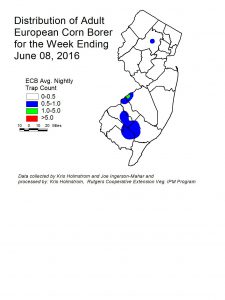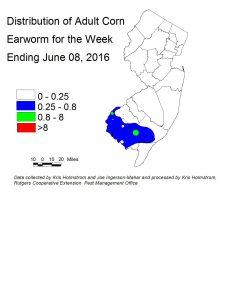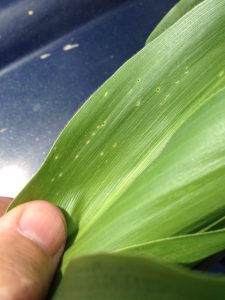Sweet Corn

 European corn borer (ECB) adult catches have declined, and are now quite low throughout the state. The most consistent catches at this time range from southwestern Burlington County through Cumberland County (see ECB map). The earliest sweet corn plantings are now silking in southern NJ, and are approaching full tassel in some northern sites. Feeding percentages are still very low (to 4% in central counties), but growers should expect that eggs are now hatching, and larval infestations could appear on all corn whorl stage and older. Be sure to begin monitoring the earliest plantings for ECB feeding while they are still in the whorl stage. Consider treating when the
European corn borer (ECB) adult catches have declined, and are now quite low throughout the state. The most consistent catches at this time range from southwestern Burlington County through Cumberland County (see ECB map). The earliest sweet corn plantings are now silking in southern NJ, and are approaching full tassel in some northern sites. Feeding percentages are still very low (to 4% in central counties), but growers should expect that eggs are now hatching, and larval infestations could appear on all corn whorl stage and older. Be sure to begin monitoring the earliest plantings for ECB feeding while they are still in the whorl stage. Consider treating when the
number of infested plants in a 50 plant sample exceeds 12%. Feeding in the whorl stage will appear as numerous small holes (called “shot-hole”) on leaves (see photo), with damage present on consecutively younger leaves. During this first ECB flight, it is advisable to make one insecticide application at the full tassel stage. This will help eliminate ECB larvae that travel from tassels down to the area where the ears are forming.
Insecticides that are acceptable in organic production include the spinosyn based material Entrust (IRAC-5) and Dipel (IRAC-11a). The 10G formulation of Dipel is particularly useful when granules can be dropped or broadcast such that they get into the whorls of corn plants. See the 2016 Commercial Vegetable Recommendations Guide for more insecticide choices.
The highest nightly ECB catches for the previous week are as follows:
| Cinnaminson 1 | East Vineland 1 | Lawrenceville 1 |
| Clinton 1 | Farmingdale 1 | Pennington 1 |
| Crosswicks 1 | Folsom 1 | |
| Downer 1 | Hillsborough 1 |
Several more corn earworm (CEW) moths were captured in the southern counties this past week. These individuals represent a limited threat to silking sweet corn at this time. The highest catches range from western Gloucester County through Atlantic County (See CEW map). Growers with silking sweet corn in shaded areas on the map should consider a 4-5 day spray schedule at this time. It is likely that this low-level population will pass soon, but these early moths often seem to cause disproportionately high damage to the few silking plantings available. Insecticide options include spinosad and spinetoram products (IRAC-5), chlorantraniliprole products (IRAC-28) as well as the synthetic pyrethroid materials (IRAC – 3). See the 2016 Commercial Vegetable Production Recommendations for a more comprehensive list of chemical options.
The highest nightly CEW catches for the previous week are as follows:
| East Vineland 1 | Folsom 1 |
| Elm 1 | Pedricktown 1 |
For silking sweet corn, the following spray schedules are warranted.
Silking Spray Schedules*:
South – 4-5 days
Central –7 days
Pepper Weevil
No pepper weevils were caught in traps this past week. Growers near Hammonton should stay vigilant for signs of weevil presence in fields now in bloom or with small fruit.
Young pepper plants are at risk of infestation from this first ECB generation. Be sure to scout fields regularly for the presence of ECB egg masses. If two or more egg masses are found in a 50 plant (two leaves/plant) sample, consider treating even if no fruit are present. In the absence of fruit, ECB larvae will bore into the central stem, topping the plant. This will result in the loss of crown fruit on infested plants. Generally, where blacklight trap catches average one or more ECB per night (blue and green areas on the ECB map) and fruit are greater than ½” in diameter, insecticides are warranted. See the 2016 Commercial Vegetable Production Recommendations for materials useful in controlling ECB.
Brown Marmorated Stink Bug
Very few brown marmorated stink bug (BMSB) adults have been captured over the past week. As numbers increase, population maps of this potential pest will appear in this publication, along with scouting information and control tactics.
Pumpkins and Winter Squash
These crops are now emerging in many areas. It is important to monitor frequently for the presence of striped cucumber beetles at this time, particularly if the seed was not purchased pre-treated with an insecticide for cucumber beetle. Check 5 consecutive plants each in 10 random locations. Examine upper and lower surface of seed leaves for the presence of beetles. Consider treating if beetles are found at 5 or more sites. Heavy, but local infestations may be spot treated. Management of these pests will limit the loss of plants to the bacterial wilt disease that the beetles transmit.
Cole Crops
Diamondback moth (DBM) and imported cabbageworm (ICW) infestations are increasing in cole crop plantings around the state. The presence of DBM does not alter the action thresholds for caterpillar pests in these crops, but it is important to avoid synthetic pyrethroid insecticides when dealing with DBM. Many populations are resistant to these chemicals. Better choices include:
(active ingredient – trade name (IRAC* code)):
Spinosad/Spinetoram – Entrust/ Radiant (5) – Entrust also OMRI approved.
Chlorantraniliprole – Coragen (28)
Cyantraniliprole – Exirel (28)
Where ICW is the dominant pest, synthetic pyrethroid (IRAC-3) materials may also be used with good success.
Scout plantings weekly. Check 5 consecutive plants each in 10 random locations throughout the planting, paying particular attention to the innermost leaves where ICW often feed. Consider treating if caterpillars are found on 10% or more plants that are in the 0-9 true leaf stage. From 9-leaf to the early head stage (in broccoli, cauliflower and cabbage) infestations up to 20% may be tolerated. Once heads begin to form, a 5% threshold should be observed to protect the marketable portion of the plant. For leafy greens such as collards and kale, 10% plants infested is the threshold throughout.


